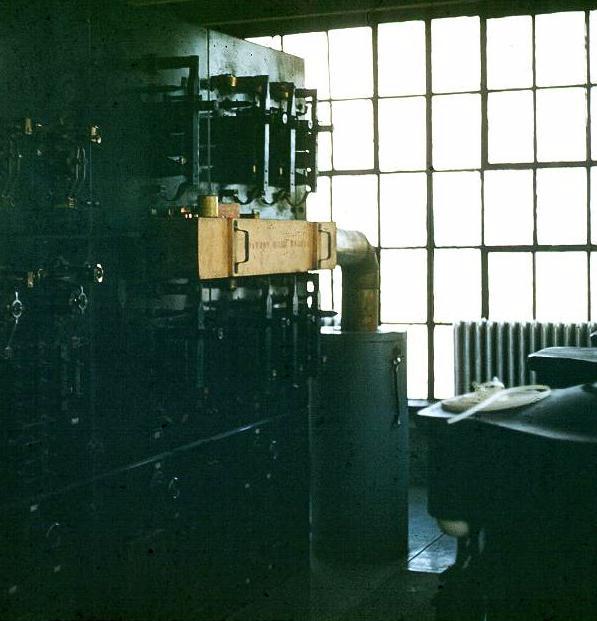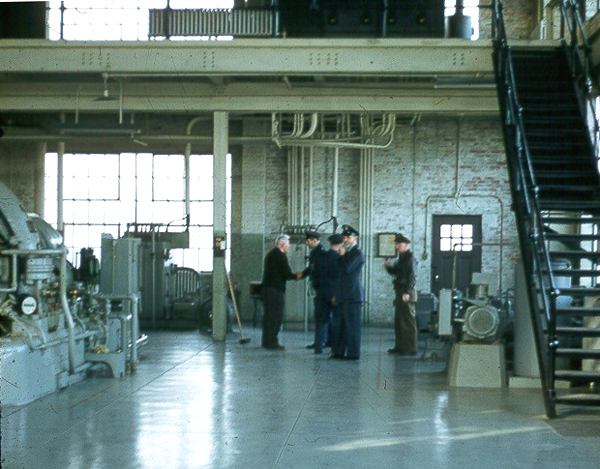BACKGROUND
Before the advent of high power vacuum tubes, one of the only practical
methods of generating large amounts of RF energy was through the use of
a motor-driven, high frequency alternator. Depending on the power level
and frequency, some of these alternators were of massive weights and dimensions.
As technology advanced, these old, electro-mechanical workhorses of the
airwaves were scrapped one by one. The Alexanderson alternator was a popular
model in its time, and today, only a single perational example survives
in the whole world. That machine, whose power output is 200 kw, is located
at the Grimeton Radiostation, 10 kilometers (6 miles) east of Varberg on
the Swedish west coast. While no longer in commercial service, station
SAQ is still in an operational state and usually makes annual transmissions
on 17.2 KHz.
During WWII, Alexanderson alternators located in Hawaii were the only
reliable long-haul method of communicating with the Pacific submarine fleet
24 hours per day, seven days a week. In the 1950's, the USAF used an Alexanderson
machine located at Marion Massachusetts, near Cape Cod . The last one in
the United States was still in service until 1960 when it was donated to
the Smithsonian Institute.
Edwin (Ed) N. Myers, Lt. Col., USAF (Ret'd) helped to commission the
unit installed at Marion Massachusetts, call sign AFA2. The frequency of
operation is not verified at this time but it was either 25.82 or 28.52.
KHz. He provides some background information about it. "The US Air Force
Communications Service bought or perhaps leased that one from RCA. The
purpose was to send Weather Sequences via RTTY to weather stations in the
Arctic - especially to the new base at Thule, Greenland. This VLF transmitter
was the only way to punch through the Northern Lights. There were
no satellites or ionospheric scatter techniques around in 1951. I was the
Air Weather Service individual in the group and based in the 8th Weather
Squadron in Newfoundland at the time. The main Air Force Communications
Service rep was an RCA Tech Rep (H. John Heffernan, now deceased) also
stationed in Newfoundland.
We were both based at Ernest Harmon AFB in Newfoundland. We both spent
time at Marion helping to get the station on the air. There were quite
a few problems that we had to solve but when it was finally debugged, we
could sent RTTY at 60 wpm. Problem was, the Comm Service Headquarters thought
the alternator it couldn't be keyed faster than 20 wpm so they ordered
20 wpm gears for all the teletype machines in the Arctic!
Instead of assigning any electronic technicians to Marion, the Comm
Service assigned mechanical techies. The Comm Service had also hired a
retired RCA engineer named Mr. Eschelman who had worked there when RCA
ran the station. There were 100% spares available at the site and none
were ever used - that was one reliable machine".
SAQ's FIRST TEST TRANSMISSION
On October 17 1996, between 0900 and 0930 hours UTC, it was planned
that the Grimeton alternator would be used to send test transmissions on
17.2 kHz (17,442 meters) in conjunction with a ceremony declaring the Grimeton
Radiostation a historic, memorial site. The call sign of SAQ was assigned
and a CW message would be sent twice in English at a speed of 12 wpm. The
keying principle of the machine is interesting. With the key up, power
is applied across a dummy load; with key down, power is sent to the antenna.
This is accomplished with a magnetic amplifier circuit (also an Alexanderson
invention) that changes a coupled circuit from being non-resonant in a
key down state to being resonant at key up state in order to absorb the
radiated load. If this was not done, there would be speed variations between
the 'load' and the 'no load states' resulting in frequency excursions.
The antenna at Grimeton is 2,280 meters (1.42 mi) long.
The alternator itself runs between 2,500 to 3,000 rpm, and needs to
be set precisely to the correct speed in order that it's 300 poles will
generate the required frequency of 17.2 kHz. In order to spin up such a
monster, a motor in the range of hundreds or horsepower is required. As
one can imagine, the noise level would be very high when the alternator
was running at full speed. In their heyday, most alternators ran on frequencies
between 10 to 30 kHz, although a few ran as high as 100 kHz. Some of these
machines could be up to 50 feet long and weigh many scores of tons. Even
the smallest alternator rated at 2 kw at 100 kHz, weighed in at several
tons and ran at a speed of 20,000 rpm. It would generate over 15 amperes
of RF current into the antenna at 130 volts. Imagine what a higher power
unit would do! Antennas for alternators were usually in the order of 1
to 3 miles long, depending on the operating frequency. Radio Central, which
used to operate on Long Island, NY had its antennas arranged like the spokes
of a giant wheel in order to reach anywhere.
RECEIVING RESULTS
Except for the northeastern seaboard of North America, the signals were
essentially unreadable on the day of the test. Some copy was possible around
Boston, but it was marginal at best. The transmission started a bit earlier
than planned at 0852 UTC with a message in English that was later repeated
four times by different operators. The final transmission ended at 0909
hours UTC.
This is a copy of the message that was sent:
CQ DE SAQ CQ DE SAQ CQ DE SAQ.
THE RADIO STATION GRIMETON IS NOW DECLARED A LISTED
HISTORIC BUILDING BY THE COUNTY COUNCIL OF HALLAND,
SWEDEN AND GOVERNOR BJOERN MOLIN. THIS MESSAGE IS
TRANSMITTED BY A 200 KW ALTERNATOR, CONSTRUCTED AT GE
BY ERNST ALEXANDERSON 80 YEARS AGO. BY SM0AGP.
73 TO THE RADIO CLUB OF AMERICA FROM SETH MYRBY + SK
Seth Myrby SM0AGP, is head of the government agency for radio communications
in Sweden. The main part of the message was then repeated by three other
operators SM6DM, SM5BF, with the last one unknown. Bengt Wilander SM7BKH,
made a successful recording of the transmission although his location was
300 km south of Grimeton and the receiving equipment not very suited for
17.2 kHz. An old DRAKE low frequency converter feeding a Collins 51S-1
receiver and an 80 meter dipole made it possible to copy the signals. In
the VLF bands, noise is 'king', so it takes some pretty sophisticated techniques
to receive weak signals. Alan Douglas, a well known radio historian and
author of the three-volume "Radio Manufacturers of the 1920's", was one
of the very few individuals who heard SAQ's transmissions in the United
States.
Credits and References:



